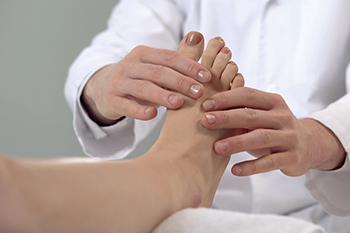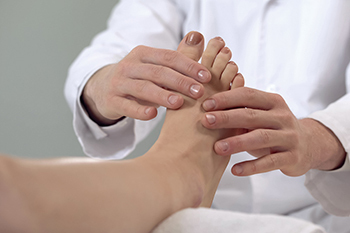(517) 487-5171
Fax (517) 908-0172
September 2022
Who Gets Cuboid Syndrome?

Cuboid syndrome can occur in an individual when the cuboid bone, located on the outer side of the foot, moves out of its place. This is typically caused by trauma or injury, and it may result in some kind of pain. Although cuboid syndrome is only 4% of all foot injuries, it can affect some individuals at a higher rate than others. For example, among professional ballet dancers, cuboid syndrome made up 17% of all foot and ankle injuries. Also, obese people and individuals who carry excessive body weight put more pressure on to their feet and are more likely to develop cuboid syndrome. If you are someone who wears shoes that do not fit properly or wears poorly constructed orthoses, then you are also at an increased risk of developing cuboid syndrome. Contact a podiatrist for advice and treatment regarding cuboid syndrome.
Cuboid syndrome, also known as cuboid subluxation, occurs when the joints and ligaments near the cuboid bone in the foot become torn. If you have cuboid syndrome, consult with Dr. Gary Cesar from Michigan Foot and Ankle Center. Our doctor will assess your condition and provide you with quality foot and ankle treatment.
Cuboid syndrome is a common cause of lateral foot pain, which is pain on the outside of the foot. The condition may happen suddenly due to an ankle sprain, or it may develop slowly overtime from repetitive tension through the bone and surrounding structures.
Causes
The most common causes of cuboid syndrome include:
- Injury – The most common cause of this ailment is an ankle sprain.
- Repetitive Strain – Tension placed through the peroneus longus muscle from repetitive activities such as jumping and running may cause excessive traction on the bone causing it to sublux.
- Altered Foot Biomechanics – Most people suffering from cuboid subluxation have flat feet.
Symptoms
A common symptom of cuboid syndrome is pain along the outside of the foot which can be felt in the ankle and toes. This pain may create walking difficulties and may cause those with the condition to walk with a limp.
Diagnosis
Diagnosis of cuboid syndrome is often difficult, and it is often misdiagnosed. X-rays, MRIs and CT scans often fail to properly show the cuboid subluxation. Although there isn’t a specific test used to diagnose cuboid syndrome, your podiatrist will usually check if pain is felt while pressing firmly on the cuboid bone of your foot.
Treatment
Just as the range of causes varies widely, so do treatments. Some more common treatments are ice therapy, rest, exercise, taping, and orthotics.
If you have any questions, please feel free to contact our offices located in Lansing and Mt. Pleasant, MI . We offer the newest diagnostic and treatment technologies for all your foot care needs.
How to Deal With Corns

A corn is a thickened area of the skin, usually on the foot, that is the result of friction from the inside of a shoe. It can have a soft or hard inner core. Hard corns generally form on top of a toe, while soft corns develop between the toes. Corns on the feet are formed from repeated pressure, which causes the skin to die and harden. A hard corn is tough and thick, often with a hard center that can cause pain if pressure, or friction, is prolonged. Moisture between the toes allows corns to soften. A soft corn looks more like an open sore, as the compressed toes rub against each other within the shoe. Changing footwear to give the toes and feet more room is the first way to avoid getting a corn. Several protective pads are available in retail stores. However, if a corn is causing extreme pain, it is a good idea to visit a podiatrist to have it examined and safely removed.
If you have any concerns regarding your feet and ankles, contact Dr. Gary Cesar of Michigan Foot and Ankle Center. Our doctor will treat your foot and ankle needs.
Corns: What Are They? and How Do You Get Rid of Them?
Corns can be described as areas of the skin that have thickened to the point of becoming painful or irritating. They are often layers and layers of the skin that have become dry and rough, and are normally smaller than calluses.
Ways to Prevent Corns
There are many ways to get rid of painful corns such as wearing:
- Well-fitting socks
- Comfortable shoes that are not tight around your foot
- Shoes that offer support
Treating Corns
Treatment of corns involves removing the dead skin that has built up in the specific area of the foot. Consult with Our doctor to determine the best treatment option for your case of corns.
If you have any questions please feel free to contact our offices located in Lansing and Mt. Pleasant, MI . We offer the newest diagnostic and treatment technologies for all your foot and ankle needs.
What Do Heel Spurs Feel Like?

When an individual develops a heel spur, a bony outgrowth on the heel points towards the arch of the foot. This outgrowth is made of a calcium deposit, and it may be pointy, hooked, or flat in shape. X-ray scans can reveal the heel spur to be up to a half of an inch in size. If you are someone who engages in significant amounts of physical activity or frequently walks on hard surfaces, you may be at an increased risk of developing heel spurs. Living with a heel spur can feel different from case to case. For example, while it can be painful for some people, others report experiencing no symptoms. However, if your case of heel spurs is painful, you could notice a kind of sharp pain in the heel. Typically, this pain can be most pronounced in the morning when you take your first steps of the day. You may also feel a diminished kind of ache in the heel throughout the rest of the day. It is also possible that the front of the heel can be swollen and inflamed. Sometimes the heel spur might even cause sensations of tenderness in the affected area. If you believe that you may have a heel spur, contact a podiatrist who can help you with your condition.
Heel spurs can be incredibly painful and sometimes may make you unable to participate in physical activities. To get medical care for your heel spurs, contact Dr. Gary Cesar from Michigan Foot and Ankle Center. Our doctor will do everything possible to treat your condition.
Heels Spurs
Heel spurs are formed by calcium deposits on the back of the foot where the heel is. This can also be caused by small fragments of bone breaking off one section of the foot, attaching onto the back of the foot. Heel spurs can also be bone growth on the back of the foot and may grow in the direction of the arch of the foot.
Older individuals usually suffer from heel spurs and pain sometimes intensifies with age. One of the main condition's spurs are related to is plantar fasciitis.
Pain
The pain associated with spurs is often because of weight placed on the feet. When someone is walking, their entire weight is concentrated on the feet. Bone spurs then have the tendency to affect other bones and tissues around the foot. As the pain continues, the feet will become tender and sensitive over time.
Treatments
There are many ways to treat heel spurs. If one is suffering from heel spurs in conjunction with pain, there are several methods for healing. Medication, surgery, and herbal care are some options.
If you have any questions feel free to contact our offices located in Lansing and Mt. Pleasant, MI . We offer the latest in diagnostic and treatment technology to meet your needs.
Four Categories of Neuropathy

A malfunction of the nerves is a condition that is referred to as neuropathy. This can happen as a result of having a specific disease, or from enduring an injury. Research has indicated that neuropathy is divided into four categories. Peripheral neuropathy generally affects the nerves that are part of the peripheral nervous system, and are located outside of the brain and spinal cord. The nerves that exit from the brain are referred to as the cranial nerves. Cranial neuropathy can happen when one of these 12 nerves become damaged. The most common types of this type of neuropathy are optic and auditory. If one of the nerves in the involuntary nervous system becomes damaged, this is known as autonomic neuropathy. Digestion, sexual response, and perspiration are governed by this set of nerves, and may affect nerves in other organs. When one nerve or one group of nerves are affected, it is known as focal neuropathy, and this is seen in one area of the body. There are existing medical conditions that can cause neuropathy, and can be common among diabetic patients. This can have a negative effect on the feet, and it may cause difficulty in feeling any cuts, bruises, or scrapes that have happened. If you have neuropathy, and have difficulty in feeling sensations in your feet, it is strongly suggested that you speak to a podiatrist as quickly as possible who can help you to manage this condition.
Neuropathy
Neuropathy can be a potentially serious condition, especially if it is left undiagnosed. If you have any concerns that you may be experiencing nerve loss in your feet, consult with Dr. Gary Cesar from Michigan Foot and Ankle Center. Our doctor will assess your condition and provide you with quality foot and ankle treatment for neuropathy.
What Is Neuropathy?
Neuropathy is a condition that leads to damage to the nerves in the body. Peripheral neuropathy, or neuropathy that affects your peripheral nervous system, usually occurs in the feet. Neuropathy can be triggered by a number of different causes. Such causes include diabetes, infections, cancers, disorders, and toxic substances.
Symptoms of Neuropathy Include:
- Numbness
- Sensation loss
- Prickling and tingling sensations
- Throbbing, freezing, burning pains
- Muscle weakness
Those with diabetes are at serious risk due to being unable to feel an ulcer on their feet. Diabetics usually also suffer from poor blood circulation. This can lead to the wound not healing, infections occurring, and the limb may have to be amputated.
Treatment
To treat neuropathy in the foot, podiatrists will first diagnose the cause of the neuropathy. Figuring out the underlying cause of the neuropathy will allow the podiatrist to prescribe the best treatment, whether it be caused by diabetes, toxic substance exposure, infection, etc. If the nerve has not died, then it’s possible that sensation may be able to return to the foot.
Pain medication may be issued for pain. Electrical nerve stimulation can be used to stimulate nerves. If the neuropathy is caused from pressure on the nerves, then surgery may be necessary.
If you have any questions, please feel free to contact our offices located in Lansing and Mt. Pleasant, MI . We offer the newest diagnostic and treatment technologies for all your foot care needs.









